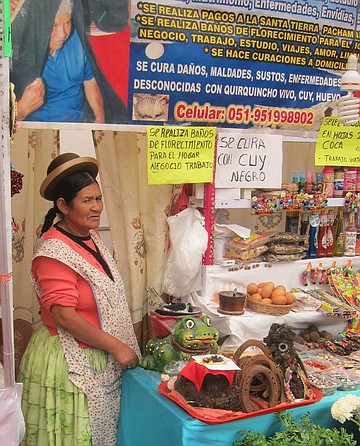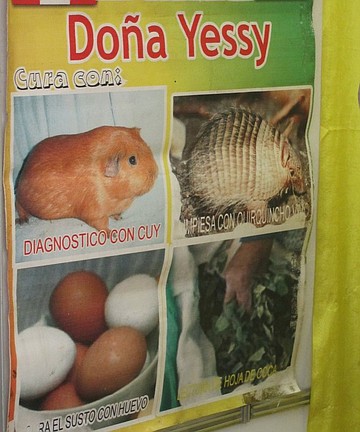 Facebook
Facebook
 X
X
 Instagram
Instagram
 TikTok
TikTok
 Youtube
Youtube

Sometimes the power of belief is the most important part of a medical treatment.

At the witches' market in Lima, Peru, the curanderos gather in early morning, setting up their stalls and hanging their banners. Crowds are already there to see them. "Curandero" is their preferred name, but some people call them shamans, and in this part of the world they are both spiritual advisors and medical healers.
Although gender is not a requirement, most are women dressed in traditional garb: bowler hats with layered petticoats. Most are chewing wads of coca leaves. Each stall holds a colorful banner proclaiming the woman’s specialty, and all have cell phone numbers and website addresses because this most ancient mode of healing is slowly using technology to advertise while keeping both feet in the old world.
Each stall is an extension of its owner/practitioner, offering talismans, potions and religious icons to the faithful. There are magnets to draw an evil spirit from a body and special paper money to bribe them when they refuse. Animal parts and ground herbs are for sale with detailed listings of their healing properties and instructions for their use. Over the silence of respect, whispered prayers and private incantations can be heard.
Then there are the guinea pigs.

At the stall of Doña Yessy who has come all the way from Bolivia, incense is burning on an impromptu altar next to prepackaged love potions and and a guidebook of how to place a spell on someone in Spanish. Her banner states “Diagnostica con cuy,” meaning she uses a guinea pig to tell her what ails her patients.
In Peru, guinea pig is a dining delicacy featured on almost every restaurant menu, but these furry little creatures are also an integral part of the curandero’s repertoire and the spiritual legacy of the country. The patient lies prone while la Doña passes the tiny pig over her body, up and down and all around, bringing to mind a sort of rodent CAT scan.
The tiny pigs, seeming to know their role, sniff the air as if scenting the patient’s ailment. Then, holding the pig next to her ear, la Doña’s face goes through a myriad of contortions as she listens to what the critter has supposedly found. Theatrics are important to establish the mood. Once the pig has diagnosed the patient’s malady, Doña Yessy will know if she has to place an egg under the table, beneath the patient’s heart, or bring in the big gun – an armadillo, whose body oils will be used to combat the ailment.
In worst cases a senior shaman may have to be called in to begin entreating the power of coca leaves, not only a natural remedy, but a vehicle to the spirit world for several millennia.
All this may sound unbelievably naïve to some readers – but is it really all that farfetched?
Most modern medicines had their origins in the rainforests of South America and were introduced to the outside world through white contact with traditional healers, shaman and medicine men on intimate terms with herbal and indigenous remedies. For many people in rural areas, it's the only form of medicine they have ever had access to. In large cities like Lima, it is not unusual to find a curandero operating from a storefront next door to a modern hospital, with patients lined up at both.

At the witches' market, there was none of the hangdog look you find in the waiting rooms of modern hospitals. The people waiting there were happy and upbeat, talking animatedly as in a party atmosphere because they all believe they will be cured. For these people, faith is the most important medicine.
As in Western medicine, ongoing education is necessary. A curandero never stops learning, reading, investigating new potions and remedies. As in all forms of shamanism, being a curandero is a lifelong commitment to helping mankind.
Before leaving, I ask Doña Yessy how the guinea pig speaks to her and she gives me an enigmatic smile, saying, “You will have to ask the pig.”
He stares at me with large unblinking eyes, saying nothing. I have neither the wisdom nor the necessary training, but I've seen too much to dispute it – in any case, it's unimportant. Here, faith is all that matters.
In Peru, a place where spiritualism goes hand in hand with modern technology, being called a witch is a high compliment.


Sometimes the power of belief is the most important part of a medical treatment.

At the witches' market in Lima, Peru, the curanderos gather in early morning, setting up their stalls and hanging their banners. Crowds are already there to see them. "Curandero" is their preferred name, but some people call them shamans, and in this part of the world they are both spiritual advisors and medical healers.
Although gender is not a requirement, most are women dressed in traditional garb: bowler hats with layered petticoats. Most are chewing wads of coca leaves. Each stall holds a colorful banner proclaiming the woman’s specialty, and all have cell phone numbers and website addresses because this most ancient mode of healing is slowly using technology to advertise while keeping both feet in the old world.
Each stall is an extension of its owner/practitioner, offering talismans, potions and religious icons to the faithful. There are magnets to draw an evil spirit from a body and special paper money to bribe them when they refuse. Animal parts and ground herbs are for sale with detailed listings of their healing properties and instructions for their use. Over the silence of respect, whispered prayers and private incantations can be heard.
Then there are the guinea pigs.

At the stall of Doña Yessy who has come all the way from Bolivia, incense is burning on an impromptu altar next to prepackaged love potions and and a guidebook of how to place a spell on someone in Spanish. Her banner states “Diagnostica con cuy,” meaning she uses a guinea pig to tell her what ails her patients.
In Peru, guinea pig is a dining delicacy featured on almost every restaurant menu, but these furry little creatures are also an integral part of the curandero’s repertoire and the spiritual legacy of the country. The patient lies prone while la Doña passes the tiny pig over her body, up and down and all around, bringing to mind a sort of rodent CAT scan.
The tiny pigs, seeming to know their role, sniff the air as if scenting the patient’s ailment. Then, holding the pig next to her ear, la Doña’s face goes through a myriad of contortions as she listens to what the critter has supposedly found. Theatrics are important to establish the mood. Once the pig has diagnosed the patient’s malady, Doña Yessy will know if she has to place an egg under the table, beneath the patient’s heart, or bring in the big gun – an armadillo, whose body oils will be used to combat the ailment.
In worst cases a senior shaman may have to be called in to begin entreating the power of coca leaves, not only a natural remedy, but a vehicle to the spirit world for several millennia.
All this may sound unbelievably naïve to some readers – but is it really all that farfetched?
Most modern medicines had their origins in the rainforests of South America and were introduced to the outside world through white contact with traditional healers, shaman and medicine men on intimate terms with herbal and indigenous remedies. For many people in rural areas, it's the only form of medicine they have ever had access to. In large cities like Lima, it is not unusual to find a curandero operating from a storefront next door to a modern hospital, with patients lined up at both.

At the witches' market, there was none of the hangdog look you find in the waiting rooms of modern hospitals. The people waiting there were happy and upbeat, talking animatedly as in a party atmosphere because they all believe they will be cured. For these people, faith is the most important medicine.
As in Western medicine, ongoing education is necessary. A curandero never stops learning, reading, investigating new potions and remedies. As in all forms of shamanism, being a curandero is a lifelong commitment to helping mankind.
Before leaving, I ask Doña Yessy how the guinea pig speaks to her and she gives me an enigmatic smile, saying, “You will have to ask the pig.”
He stares at me with large unblinking eyes, saying nothing. I have neither the wisdom nor the necessary training, but I've seen too much to dispute it – in any case, it's unimportant. Here, faith is all that matters.
In Peru, a place where spiritualism goes hand in hand with modern technology, being called a witch is a high compliment.
Comments